Startups Developing Exoskeleton, Eggsorter for Labs, Force Sensing Solution for Robots and Making Brain Concussion Diagnosis Possible Each win CHf 10’000
21.01.2020
Autonomyo, Bionomous, Bota and C-MedTec Teams win Venture Kick’s financial and entrepreneurial support. Their projects help patients with reduced mobility for rehabilitation, develop next-generation Eggsorter bringing automation to the lab or a force-sensing solution for robots, and help better diagnose concussion in shock risky activities and sports.
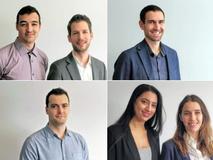 |
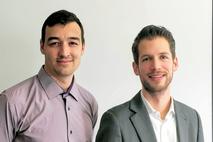 Autonomyo's CTO Amalric Ortlieb and CMO Fabian-Bischof
|
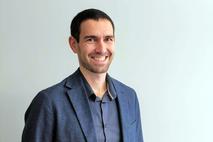 Bionomous's CEO Franck Bonnet
|
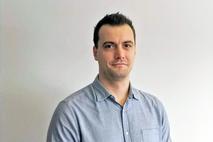 BOTA's CEO Klajd Lika
|
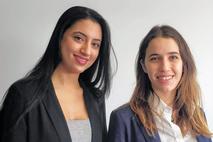 C-MedTec's cofounders Hana Samet and Stefania Konstantinidi
|
Autonomyo: Robotic lower limb exoskeleton
Autonomyo has developed a control mechanism for human-robot interaction that leaves the patient more in charge of the movement and thus emphasis the training aspect of the session. It is a robotic lower limb exoskeleton for daily training and rehabilitation at home with personalized assistance levels. It is stimulating physical and mental training of movements. Autonomyo is developed at EPFL at the REHAssist Lab by the team of Amalric Ortlieb who did his PhD on the project and still is part the EPFL REHAssist Lab. A first clinical evaluation together with CHUV is also funded and started in 2019. To develop Autonomyo, the team is currently looking for funding for the engineering team for 2020 plus, to speed up the product development for hard and software and for the follow up clinical studies and to register the medical device.
Bionomous : Eggsorter bringing automation to the lab
Bionomous’ CEO Frank Bonnet has obtained a PhD at the EPFL and is currently employed by the EPFL as a Postdoc, working at 100% on the Bionomous project. Bionomous aims at bringing to the market new solutions that combines innovative micro-engineering design and machine learning methods to automatically count, screen, sort and dispense miniature biological entities like the egg of zebrafish Danio rerio which is a growing model in research and industry in genetics, development biology or toxicology. They plan to use the Venture Kick funds to finance the latest stage of development and manufacturing of the first versions of their product by February 2020, and for marketing material to be ready for sales by Summer 2020.
BOTA: Force-sensing solution for robots
By 2023, more than half a million industrial robots will be collaborating with humans, and hence require force sensing technology. In contrast to existing industrial solutions, this requires tactile and force controllable systems. BOTA’s CEO, Klajd Lika graduated in Engineering from National Technical University of Athens (MA equivalent) has been working in Robotic Systems Lab of ETH Zurich. With his team, they developed an innovative plug and play force-sensing solution which is scalable, highly integrated and modular and can be integrated in systems like collaborative manipulators, service and household robots, or healthcare solutions. It make them sense the interaction force with their environment. The funds will be used for paying part of the engineers’ salaries and for the marketing to scale up the sales.
C-MedTEC: Making Brain Concussion Diagnosis Possible
As of today, detecting concussion can only be done through a pen and paper test that has be done by trained professionals. Hence, no diagnosis, leads to no proper rest, which leads to a higher risk of repeated brain concussion leading to Long-term effects and chronic diseases such as Alzheimer et CTE. The aim of C-MedTec is to design a diagnosis helmet helping sport practitioners to behave in a healthy way. Stefania Konstantinidi, MSc in Medical Robotics and Hana Samet, MSc in Micro-Engineering are the co-founders of C-Medtec based at the EPFL Lausanne. C Medtec has two devices. One integrated in a helmet monitoring head shocks to avoid concussions from developing in sports or activites with risk of shock. The second product is measuring the brain metabolism and pick up undesired neurological behavior after the brain is exposed to a shock. Both devices will be connected to an app as that will allow the user to perform digital neuropsychological and cognitive assessments.
Autonomyo has developed a control mechanism for human-robot interaction that leaves the patient more in charge of the movement and thus emphasis the training aspect of the session. It is a robotic lower limb exoskeleton for daily training and rehabilitation at home with personalized assistance levels. It is stimulating physical and mental training of movements. Autonomyo is developed at EPFL at the REHAssist Lab by the team of Amalric Ortlieb who did his PhD on the project and still is part the EPFL REHAssist Lab. A first clinical evaluation together with CHUV is also funded and started in 2019. To develop Autonomyo, the team is currently looking for funding for the engineering team for 2020 plus, to speed up the product development for hard and software and for the follow up clinical studies and to register the medical device.
Bionomous : Eggsorter bringing automation to the lab
Bionomous’ CEO Frank Bonnet has obtained a PhD at the EPFL and is currently employed by the EPFL as a Postdoc, working at 100% on the Bionomous project. Bionomous aims at bringing to the market new solutions that combines innovative micro-engineering design and machine learning methods to automatically count, screen, sort and dispense miniature biological entities like the egg of zebrafish Danio rerio which is a growing model in research and industry in genetics, development biology or toxicology. They plan to use the Venture Kick funds to finance the latest stage of development and manufacturing of the first versions of their product by February 2020, and for marketing material to be ready for sales by Summer 2020.
BOTA: Force-sensing solution for robots
By 2023, more than half a million industrial robots will be collaborating with humans, and hence require force sensing technology. In contrast to existing industrial solutions, this requires tactile and force controllable systems. BOTA’s CEO, Klajd Lika graduated in Engineering from National Technical University of Athens (MA equivalent) has been working in Robotic Systems Lab of ETH Zurich. With his team, they developed an innovative plug and play force-sensing solution which is scalable, highly integrated and modular and can be integrated in systems like collaborative manipulators, service and household robots, or healthcare solutions. It make them sense the interaction force with their environment. The funds will be used for paying part of the engineers’ salaries and for the marketing to scale up the sales.
C-MedTEC: Making Brain Concussion Diagnosis Possible
As of today, detecting concussion can only be done through a pen and paper test that has be done by trained professionals. Hence, no diagnosis, leads to no proper rest, which leads to a higher risk of repeated brain concussion leading to Long-term effects and chronic diseases such as Alzheimer et CTE. The aim of C-MedTec is to design a diagnosis helmet helping sport practitioners to behave in a healthy way. Stefania Konstantinidi, MSc in Medical Robotics and Hana Samet, MSc in Micro-Engineering are the co-founders of C-Medtec based at the EPFL Lausanne. C Medtec has two devices. One integrated in a helmet monitoring head shocks to avoid concussions from developing in sports or activites with risk of shock. The second product is measuring the brain metabolism and pick up undesired neurological behavior after the brain is exposed to a shock. Both devices will be connected to an app as that will allow the user to perform digital neuropsychological and cognitive assessments.


